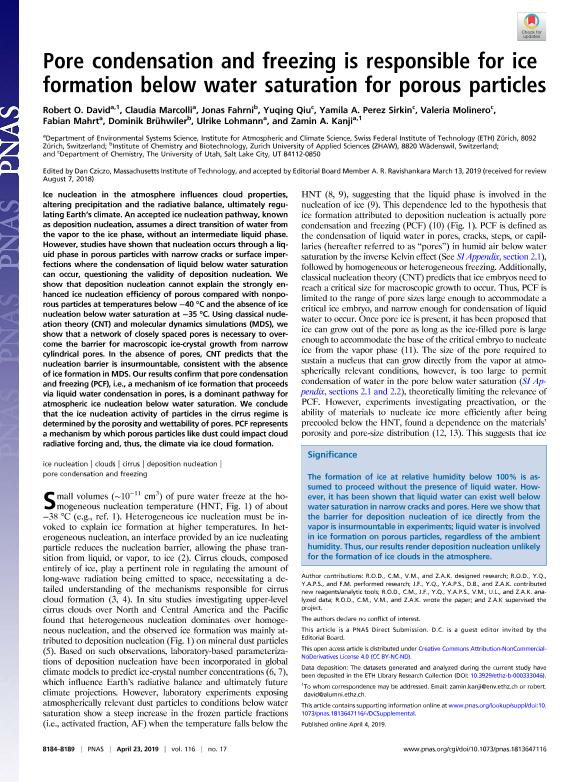Mostrar el registro sencillo del ítem
dc.contributor.author
David, Robert O.
dc.contributor.author
Marcolli, Claudia
dc.contributor.author
Fahrni, Jonas
dc.contributor.author
Qiu, Yuqing
dc.contributor.author
Pérez Sirkin, Yamila Anahí

dc.contributor.author
Molinero, Valeria
dc.contributor.author
Mahrt, Fabian
dc.contributor.author
Brühwiler, Dominik
dc.contributor.author
Lohmann, Ulrike
dc.contributor.author
Kanji, Zamin A.
dc.date.available
2021-01-26T13:40:05Z
dc.date.issued
2019-04
dc.identifier.citation
David, Robert O.; Marcolli, Claudia; Fahrni, Jonas; Qiu, Yuqing; Pérez Sirkin, Yamila Anahí; et al.; Pore condensation and freezing is responsible for ice formation below water saturation for porous particles; National Academy of Sciences; Proceedings of the National Academy of Sciences of The United States of America; 116; 17; 4-2019; 8184-8189
dc.identifier.issn
0027-8424
dc.identifier.uri
http://hdl.handle.net/11336/123701
dc.description.abstract
Ice nucleation in the atmosphere influences cloud properties, altering precipitation and the radiative balance, ultimately regulating Earth’s climate. An accepted ice nucleation pathway, known as deposition nucleation, assumes a direct transition of water from the vapor to the ice phase, without an intermediate liquid phase. However, studies have shown that nucleation occurs through a liquid phase in porous particles with narrow cracks or surface imperfections where the condensation of liquid below water saturation can occur, questioning the validity of deposition nucleation. We show that deposition nucleation cannot explain the strongly enhanced ice nucleation efficiency of porous compared with nonporous particles at temperatures below −40 °C and the absence of ice nucleation below water saturation at −35 °C. Using classical nucleation theory (CNT) and molecular dynamics simulations (MDS), we show that a network of closely spaced pores is necessary to overcome the barrier for macroscopic ice-crystal growth from narrow cylindrical pores. In the absence of pores, CNT predicts that the nucleation barrier is insurmountable, consistent with the absence of ice formation in MDS. Our results confirm that pore condensation and freezing (PCF), i.e., a mechanism of ice formation that proceeds via liquid water condensation in pores, is a dominant pathway for atmospheric ice nucleation below water saturation. We conclude that the ice nucleation activity of particles in the cirrus regime is determined by the porosity and wettability of pores. PCF represents a mechanism by which porous particles like dust could impact cloud radiative forcing and, thus, the climate via ice cloud formation.
dc.format
application/pdf
dc.language.iso
eng
dc.publisher
National Academy of Sciences

dc.rights
info:eu-repo/semantics/openAccess
dc.rights.uri
https://creativecommons.org/licenses/by-nc-sa/2.5/ar/
dc.subject
CIRRUS
dc.subject
CLOUDS
dc.subject
DEPOSITION NUCLEATION
dc.subject
ICE NUCLEATION
dc.subject
PORE CONDENSATION AND FREEZING
dc.subject.classification
Físico-Química, Ciencia de los Polímeros, Electroquímica

dc.subject.classification
Ciencias Químicas

dc.subject.classification
CIENCIAS NATURALES Y EXACTAS

dc.title
Pore condensation and freezing is responsible for ice formation below water saturation for porous particles
dc.type
info:eu-repo/semantics/article
dc.type
info:ar-repo/semantics/artículo
dc.type
info:eu-repo/semantics/publishedVersion
dc.date.updated
2020-11-20T14:50:10Z
dc.journal.volume
116
dc.journal.number
17
dc.journal.pagination
8184-8189
dc.journal.pais
Estados Unidos

dc.description.fil
Fil: David, Robert O.. Institute for Atmospheric and Climate Science; Suiza
dc.description.fil
Fil: Marcolli, Claudia. Institute for Atmospheric and Climate Science; Suiza
dc.description.fil
Fil: Fahrni, Jonas. Zurich University of Applied Sciences; Suiza
dc.description.fil
Fil: Qiu, Yuqing. University of Utah; Estados Unidos
dc.description.fil
Fil: Pérez Sirkin, Yamila Anahí. University of Utah; Estados Unidos. Consejo Nacional de Investigaciones Científicas y Técnicas. Oficina de Coordinación Administrativa Ciudad Universitaria. Instituto de Química, Física de los Materiales, Medioambiente y Energía. Universidad de Buenos Aires. Facultad de Ciencias Exactas y Naturales. Instituto de Química, Física de los Materiales, Medioambiente y Energía; Argentina
dc.description.fil
Fil: Molinero, Valeria. University of Utah; Estados Unidos
dc.description.fil
Fil: Mahrt, Fabian. Institute for Atmospheric and Climate Science; Suiza
dc.description.fil
Fil: Brühwiler, Dominik. University of Applied Sciences; Suiza
dc.description.fil
Fil: Lohmann, Ulrike. Institute for Atmospheric and Climate Science; Suiza
dc.description.fil
Fil: Kanji, Zamin A.. Institute for Atmospheric and Climate Science; Suiza
dc.journal.title
Proceedings of the National Academy of Sciences of The United States of America

dc.relation.alternativeid
info:eu-repo/semantics/altIdentifier/url/https://www.pnas.org/content/pnas/116/17/8184.full.pdf
dc.relation.alternativeid
info:eu-repo/semantics/altIdentifier/doi/http://dx.doi.org/10.1073/pnas.1813647116
Archivos asociados
